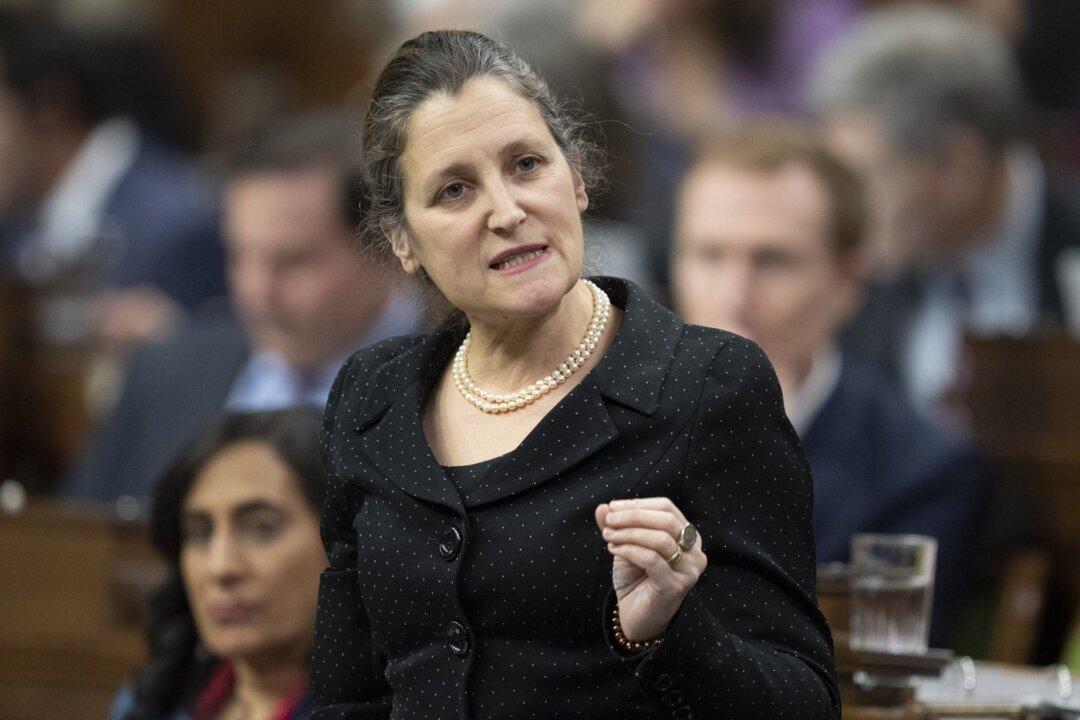Canada’s federal debt-to-GDP ratio will grow and remain above its 2022–23 level for two years before gradually declining over the medium term, according to an assessment by the Parliamentary Budget Officer (PBO), despite the federal government’s earlier promises of deficit reduction.
Budget 2023 projected that the ratio would rise from 42.4 percent in 2022–23 to 43.5 percent and then 43.2 percent respectively for the next two years, before starting to fall below the 2022–23 level, and that it would decline to 39.9 percent in 2027–28.
Finance Minister Chrystia Freeland had said on April 7, 2022, upon the release of Budget 2022, that the federal government was “absolutely determined that our debt-to-GDP ratio must continue to decline.”
“This is our fiscal anchor, a line we shall not cross, and that will ensure our finances remain sustainable for so long as it remains unbreached,” she said.
“We will review and reduce government spending, because that is the responsible thing to do,” she said, reported by Blacklock’s Reporter.
In a report released on April 13, the PBO also criticized the “lack of transparency” provided in Budget 2023 concerning $798 million in net new, previously unannounced measures over fiscal years 2022–23 to 2027–28.
“This lack of transparency presents challenges for parliamentarians and the public in scrutinizing the government’s spending plans,” said the report, “Budget 2023: Issues for Parliamentarians.”
PBO Yves Giroux said in the report, “In absolute terms, this represents over $12 billion in either revenue or spending decisions for which there are no specific details.”
He said it also impacts reconciling previous allocated budget amounts.
“This was the first time since Budget 2021 that the Government revised down its outlook for the budgetary balance prior to including new measures. Following this downward revision, the Government announced $69.7 billion in new spending that was partially financed by $14.0 billion in revenue raising measures and by $12.8 billion in spending restraint measures,” said Giroux in an April 13 news release announcing release of his report.
Giroux added that Budget 2023 “does not provide an assessment of program effectiveness that the Government launched in last year’s budget under its comprehensive Strategic Policy Review.”
He said the new budget also does not “identify opportunities to save and reallocate resources to adapt government programs and operations to a new post-pandemic reality.”
Targets
Parliament has not balanced a budget since 2007. In Giroux’s testimony at the Senate national finance committee in 2020, he said cabinet must control spending by setting targets.
“We have to have targets,” he testified. “The absence of a fiscal anchor can be equated with uncertainty,” he said, adding that “there is no clear path forward for the government’s finances. That’s a big question mark.”
Giroux suggested that if the government implemented targets, it would “provide a sense of direction, a sense of cohesion” that would let taxpayers anticipate future federal policies.
“Regardless of whether it be a balanced budget come hell or high water, as we had in the late 1990s, or a declining debt-to-GDP ratio, or a certain level of growth in expenditures, but something that can anchor expectations,” he said.
Giroux questioned the government’s priorities. “Where is the government headed in a very general sense? Are we headed for very tight fiscal discipline, or are we headed for mild discipline, or are we headed for no discipline at all?” he said at the time.
Senators also expressed alarm in 2020 at the dramatic increase in the federal debt, which according to Public Accounts sits now at more than $1.1 trillion.
At the time, Quebec Senator Éric Forest said, “We need to have a point of reference because the debt—for Canadians and for senators also—is becoming humongous.”





